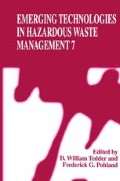Abstract
The U.S. Department of Energy (DOE) is defining decontamination and decommissidning (D&D) obligations at its sites (1). Current D&D activities are generally labor in-te sive, use chemical reagents that are difficult to treat, and may expose workers to radioactive and hazardous chemicals (1). Therefore, new technologies are desired that minimize waste, allow much of the decommissioned materials to be reused rather than disposed of as waste, and produce wastes that will meet disposal criteria (1).
The O’Brien & Gere Companies tested a scouring decontamination system on concrete and steel surfaces contaminated with radioactive and hazardous wastes under the sponsorship of Martin Marietta Energy Systems, Inc. (MMES) at DOE’s K-25 former gaseous diffusion plant in Oak Ridge, Tennessee. This former gaseous diffusion plant separated uranium-235 from uranium ore for use in atomic weapons and commercial reactors. The scouring system that O’Brien & Gere Companies developed removes fixed radioactive and hazardous surface contamination, while leaving the surface intact. Blasting residuals are dissolved and treated using physical/chemical processes.
Bench-and pilot-scale testing of the soda blasting system was conducted between December 1993 and September 1994 on surfaces contaminated with uranium, technetium, heavy metals, and PCBs. Areas of concrete and metal surfaces were blasted. Blasting re-siduals were dissolved in tap water and treated for radioactive, hazardous, and organo-chlorine constituents. The treatment system comprised pH adjustment, aeration, solids settling, filtration, carbon adsorption, and ion exchange. This system produced treated water and residual solid waste.
Testing demonstrated that the system is capable of removing greater than 95% of radioactive and PCB surface contamination to below DOE’s unrestricted use release limits; aqueous radionuclides, heavy metals, and PCBs were below DOE and USEPA treatment objectives after blasting residuals treatment. Waste residuals volume was decreased by 71%. Preliminary analyses suggest that this soda blasting/waste residuals treatment system provides significant waste volume reduction and is more economical than surface decontamination techniques that are commercially available or under development.
Access this chapter
Tax calculation will be finalised at checkout
Purchases are for personal use only
Preview
Unable to display preview. Download preview PDF.
References
Martin Marietta Energy Systems, Inc., Decontamination and Decommissioning Technology Assessment, Prepared under contract with the U.S. Department of Energy, Oak Ridge, TN, March 1993.
Bostick, W.D., Bush, S.A., Marsh, G.C., and Henson, H.M., Electroosmotic Decontamination of Concrete, Prepared under contract with the U.S. Department of Energy, Oak Ridge, TN, March 1993.
Saraceno, A.J., The Control of Technetium at the Portsmouth Gaseous Diffusion Plant, Prepared under contract with the U.S. Department of Energy through Goodyear Atomic Corporation, Piketon, OH, November 1981.
Erickson, M.D., Analytical Chemistry of PCBs, Lewis, Boca Raton, 1992.
U.S. Envi ronmental Protection Agency, 40 CFR 761.125, 1993.
U.S. Department of Energy, Office of Environment, Safety, and Health, Radiation Protection of the Public and the Environment, Order DOE 5400.5, February 1990.
U.S. Environmental Protection Agency, Safe Drinking Water Act, 1986.
Perry, R.H., Perry’s Chemical Engineers’ Handbook, 6th Ed., McGraw-Hill, New York, 1984.
Basic In Flow, Chemicals Used in Treatment of Water and Wastewater: Engineering Data, Reference 1.21–15, October 1976.
Sorg, T.J., Methods for Removing Uranium from Drinking Water, Journal WWA,July 1988.
Meyer, R.E. et al., Thermodynamic Properties of Tc (IV) Oxides: Solubilities and the Electrode Potential of the Tc (VII)/Tc (IV) - Oxide Couple, Prepared under contract with the U.S. Nuclear Regulatory Commission, May 1988.
Wildung, R.E., McFadden, K.M., and Garland, T.R., Technetium Sources and Behavior In the Environment, Journal of Environmental Quality, Vol. 8, (2), 1979.
Bostick, W.D. and Evans-Brown, B., Sorptive Removal of Technetium from Heavy Metal Sludge Filtrate Containing Nitrate Ion, Prepared under contract with the U.S. Department of Energy, Oak Ridge, TN, January 1988.
Kotegov et al., Technetium, in Advances in Inorganic Chemistry and Radiochemistry, Vol. II, pp. 1–90, Academic Press, New York, 1968.
Eckenfelder, W.W., Industrial Water Pollution Control, 2nd Ed., McGraw-Hill, New York, 1989.
Mackay, D., Shiu, W.Y., Ma, K.C., Illustrated Handbook of Physical-Chemical Properties and Environmental Fate for Organic Chemicals, Vol. I, Lewis Publishers, Boca Raton, 1991.
American Public Health Association (APHA), Standard Methods for the Examination of Water and Wastewater, 17th Ed., APHA.
Dobbs, R.A., Cohen, J.Carbon Adsorption Isotherms for Toxic Organics, EPA-600/8–80–023, April1980.
Author information
Authors and Affiliations
Editor information
Editors and Affiliations
Rights and permissions
Copyright information
© 1997 Springer Science+Business Media New York
About this chapter
Cite this chapter
Grieco, S.A., Neubauer, E.D., Rhea, J.R. (1997). Removal and Treatment of Radioactive, Organochlorine, and Heavy Metal Contaminants From Solid Surfaces. In: Tedder, D.W., Pohland, F.G. (eds) Emerging Technologies in Hazardous Waste Management 7. Springer, Boston, MA. https://doi.org/10.1007/978-1-4615-5387-8_16
Download citation
DOI: https://doi.org/10.1007/978-1-4615-5387-8_16
Publisher Name: Springer, Boston, MA
Print ISBN: 978-1-4613-7459-6
Online ISBN: 978-1-4615-5387-8
eBook Packages: Springer Book Archive

